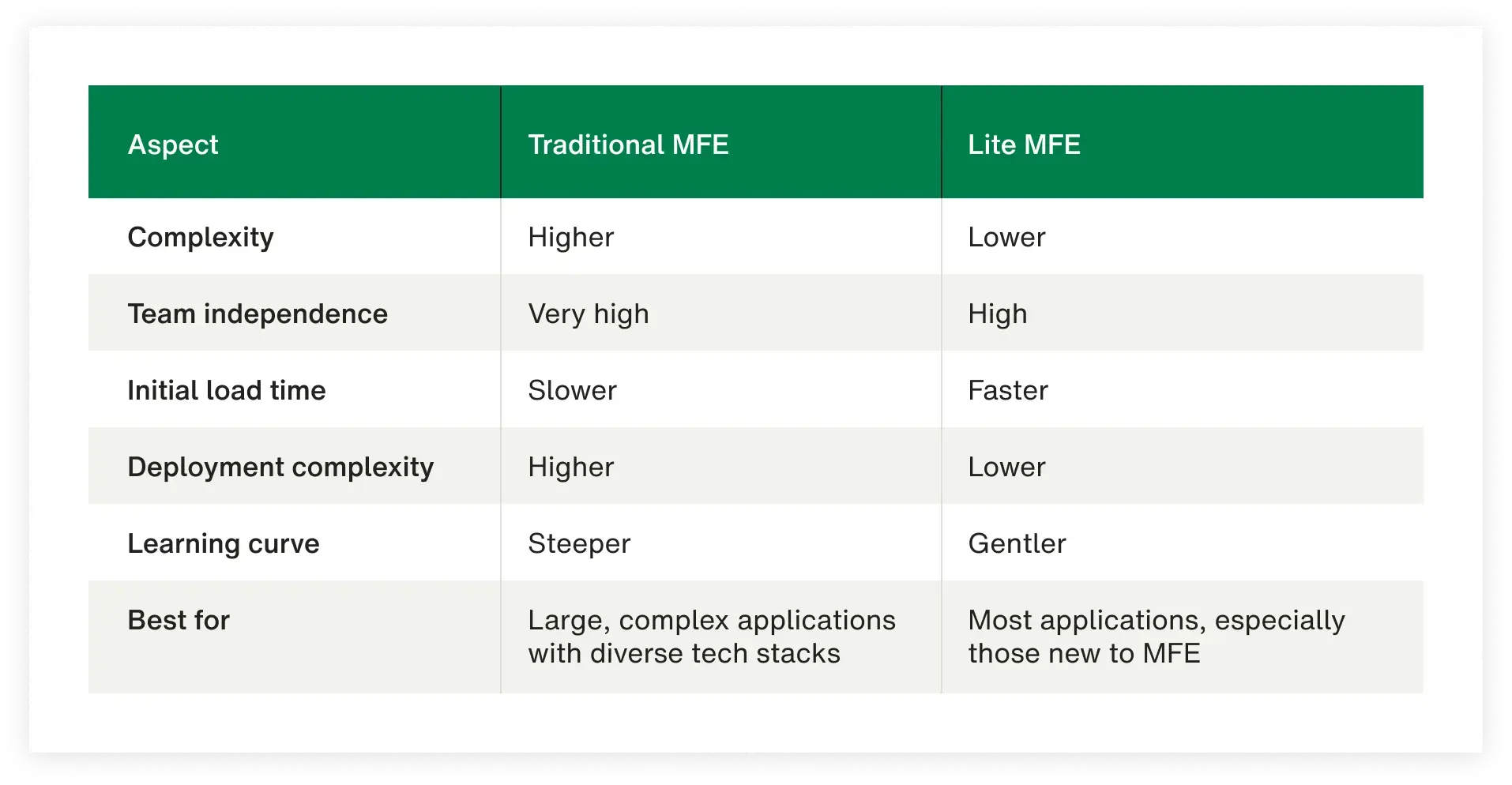Shipping digital products at scale: How developing with micro frontends reduces risk and boosts agility

Jyoti Singh
Manager, Engineering

Your modern web app may be growing too much for its own good. As applications swell in size, they become harder to maintain, slower to release and riskier to change. It's like trying to run a five-star sushi, burger and pizza joint from one chaotic kitchen — something's bound to go wrong.
That’s where micro frontends (MFEs) come in.
These architectural patterns offer a business-friendly solution that helps teams move faster, release with confidence and reduce coordination overhead. This means quicker time to market, lower deployment risk and greater scalability — both technically and organizationally.
If you've ever felt the pain of slow releases, tangled codebases or interdependent teams, MFEs could be the key to unlocking long-term agility and growth.
What exactly is a micro frontend (MFE)?
An MFE is an architectural pattern that breaks down a web application's frontend into smaller modules, which can be independently developed and deployed. Each module typically handles a specific feature — like a cart, profile or dashboard — and comes with its own:
- Source code repository
- Dependency management
- Test suite
- CI/CD pipeline
These modules are stitched together at runtime using tools like Webpack Module Federation, web components and single-SPA to enable dynamic code sharing and runtime integration.
Why should you care about MFEs?
If you’ve ever said, “This project is getting out of hand,” you're probably already a good candidate for MFEs. Here’s why they’re worth considering:
- Scalability: Different teams can develop and scale modules in parallel.
- Independent deployment: Modules can ship independently, reducing risk and enabling faster releases.
- Technology flexibility: Each team can choose the best tech for their module (React, Angular, Vue — you name it).
- Modular codebase: This is easier to maintain, test and extend.
- Incremental migration: You’ll be able to modernize legacy apps piece by piece.
- Improved team autonomy: Less coordination overhead is required, allowing for more focused, faster development.
Where do MFEs fit in modern architecture?
In a typical modern application architecture, developers can seamlessly integrate MFEs to manage different frontend modules. These modules are typically integrated into the larger application via a backend for frontend (BFF) layer, which facilitates communication between the frontend and backend services. Cloud platforms, like Google Cloud Platform (GCP) or Amazon Web Services (AWS), typically host the system, ensuring scalability, security and data protection.
For backend processes, developers use microservices, which are containerized and deployed with platforms like Kubernetes to manage resources efficiently.
For frontend integration, an API gateway handles routing, authentication and rate limiting, ensuring smooth communication between the frontend and backend layers.
Now that we understand where MFEs fit within the broader architectural landscape, let's explore the two main implementation approaches. Your choice between these strategies will significantly impact your development experience, team structure and application performance.
How do you choose the right MFE approach?
The MFE ecosystem offers two primary implementation strategies — traditional MFE and lite MFE. Each has its own unique strengths, trade-offs and ideal use cases.
Traditional MFE
This model uses custom frameworks with tailored lifecycles and communication patterns. It’s suited for large, complex applications that require high scalability and team independence.
To understand traditional MFE, picture a sprawling food complex where each restaurant has its own kitchen, staff and branding. Each restaurant can innovate independently, serve on its own schedule and customize its kitchen. However, because each restaurant is self-contained, it comes with duplicate costs: separate staff, equipment and infrastructure.
It’s worth noting that a complex MFE implementation requires slower initial load times, due to multiple bundles, potential dependency conflicts and a heavier operational burden. As a result, deployments become more complex, and the required custom tooling and structure can make onboarding new developers challenging.
Lite MFE
The lite MFE model takes a streamlined approach by using standard React patterns and avoiding custom lifecycles. Think of it like a food court. Each stall serves a unique cuisine, but they all share common infrastructure like seating, utilities and payment systems. This model is cost-effective, easier to maintain and still gives each team the flexibility to focus on its specialty.
By reducing duplication and complexity, lite MFE improves load times, simplifies deployments (especially with platforms like Vercel or Netlify) and shortens onboarding time for new developers. Teams that are new to micro frontends or those seeking to minimize overhead while maintaining modularity should find lite MFE especially appealing.
Comparing MFE implementation strategies
To help you decide on the best approach for your project, we've created this comparison chart:

Understanding the trade-offs should help you choose the approach that best fits your team's needs and capabilities.
You can eliminate much of the boilerplate and configuration overhead associated with MFE architecture by using modern tooling:
- Webpack 5 Module Federation forms the foundation, supported by tools like @module-federation/nextjs-mf for Next.js apps and Create-MFE-App for quick scaffolding.
- Libraries like Redux Toolkit or Zustand work well for shared state management, while Nx or Turborepo can help organize and manage a monorepo structure.
- Hosting platforms such as Vercel and Netlify offer built-in support, making deployment seamless.
Conclusion: Embracing the future of frontend development
By breaking down complex apps into smaller, independent modules, teams can scale, deploy and innovate more rapidly. Lite MFE, in particular, offers faster deployment times, better load performance and smoother onboarding, making it easier to handle complex projects without drowning in technical debt.
Adopting this approach will better equip teams to build next-gen apps that keep up with evolving tech and user demands. And hey, anything that makes dev-life a bit easier is a win in my book!
Next steps
If you're considering implementing micro frontends in your organization, here are some actionable next steps:
- Assess your current architecture and identify pain points that MFEs could address.
- Choose between traditional and lite MFE based on your team's needs and capabilities.
- Start small by implementing MFEs in a non-critical part of your application.
- Invest in tooling and automation to streamline the MFE development and deployment process.
- Train your team on MFE concepts and best practices to ensure smooth adoption.




